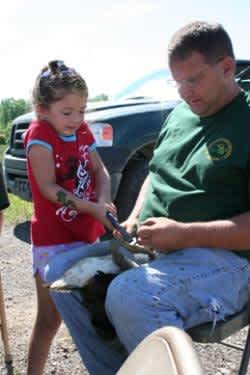Hundreds of Geese Banded in Southeast Michigan

Michigan Department of Natural Resources wildlife biologists, staff and volunteers helped to round up and band over 1,000 Canada geese in Southeast Michigan last month.
The geese were banded as part of a national effort to track the population and movement of Canadian geese in the United States. In North America, biologists band more than 200,000 ducks and nearly 150,000 geese and swans each year.
In the latter part of June, geese molt their primary flight feathers and are unable to fly, making them easier to capture and band.
“We banded 170 birds at three locations in Jackson and Hillsdale counties,” said DNR wildlife biologist Kristin Bissell. “We had 11 very enthusiastic, hard-working volunteers who helped make it a success! We’re happy that a sample of the geese from the south central portion of the state will be represented in the banding effort!”
During the banding process, geese are herded into temporary pens, where they are then captured and passed to a waiting biologist. The biologist determines the sex and age of the goose and then gives each goose a silver U.S. Fish and Wildlife Service leg band with a serial number. This number is recorded and later entered into a national database. The geese are then promptly released unharmed.
“One of the first uses of banding and recovery location data was to help biologists determine waterfowl migration routes,” said DNR waterfowl specialist Barb Avers. “By banding ducks and geese in the northern breeding areas and then marking the points where hunters and others recovered them, biologists identified the four major migratory pathways, or flyways, that cross North America.”
Band recovery data show biologists how the harvest is distributed throughout the flyway. Biologists also can estimate annual harvest rates, and even annual survival rates, for some waterfowl species from band recovery data. The annual variation in harvest and survival rates has helped biologists understand how breeding habitat conditions and harvest regulations affect survival. These harvest and survival rates are critical pieces of information used to help determine appropriate hunting regulations each year.
Hunters who find a band on their bagged geese are asked to call the 800 number listed on the band to report the band number, or visit the Bird Banding Laboratory’s website (also listed on the band) to enter the band number. They will then receive a certificate listing the bird’s approximate age and where it was banded.
About 85,000 to 90,000 bands are reported each year. The oldest known waterfowl banded in North America was a Canada goose that lived to be 30 years and four months old.

